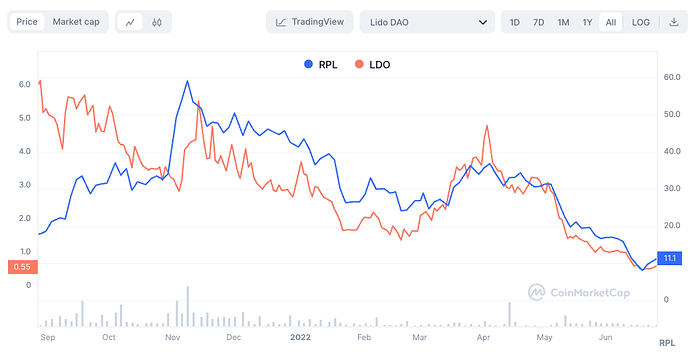Hello, RP community! In response to the recent tokenomics discussions, NodeSet has prepared a full, 27-page report on the subject. Please see below for an overview and summary.
This report is not yet as complete as we would like, but it appears the conversation is moving at substantial speed and a decision is being encouraged despite the draft status of existing proposals. In particular, we note that this report needs more citations and further editing. We invite the community to help contribute, comment, and continue the research.
We are also drafting RPIPs for our own proposals listed in this report. We encourage everyone to be patient while these ideas are formalized further.
Finally, I want to thank the following folks for their pre-publication comments and editing: @ken @Marceau @samus @rocknet @ib1gymnast @waqwaqattack
Version 1.1 - Improved Example Roadmap section
Overview
In this report, we analyze RPL in the context of the current use case and what makes it sustainable. Additionally, we consider how the current indirect model compares to the proposed direct revenue approach. Next, we analyze the proposed tokenomics rework and assess the risks associated with each component individually and in totality. Lastly, we evaluate the impact of these proposed changes on NodeSet’s work before suggesting an alternative proposal.
Abstract
The current tokenomics proposal that has received the most attention fundamentally changes the relationship between RPL and the protocol and, therefore, the relationships between stakeholders in the system. Our findings indicate that the proposed new dynamics may be less healthy than existing dynamics because they create a financialized shareholder class that is economically incentivized to exploit the other actors (NOs, rETH holders) who make the system run, necessarily changing the makeup of these groups over time. In turn, this is likely to eventually lead to systemic instability and a transformation of RP into a protocol dominated by ungovernable large actors.
While RPL exists today as a utility token with an indirect revenue model fundamentally tied to node operation, the new proposals shift it towards an asset that can be priced more concretely by the market through ETH revenue accrual, opening it to increased levels of speculator ownership rather than participant ownership. Although this may make RPL more attractive to some, it does so by taking value from existing and future NOs, and for many scenarios, there is little change in terminal valuation versus existing tokenomics. Potential mitigations are suggested to prevent the optimization of the RPL/ETH ratio from overshadowing these and other serious risks associated with the proposed tokenomics changes.
Additionally, these changes would significantly impact NodeSet’s ability to grow Rocket Pool with Constellation. Altering tokenomics after the upcoming release of Constellation might, at worst, prevent its operation. At best, these changes would reduce its positive impact and delay future development to focus on complying with new changes to RP. Therefore, we suggest a different path.
